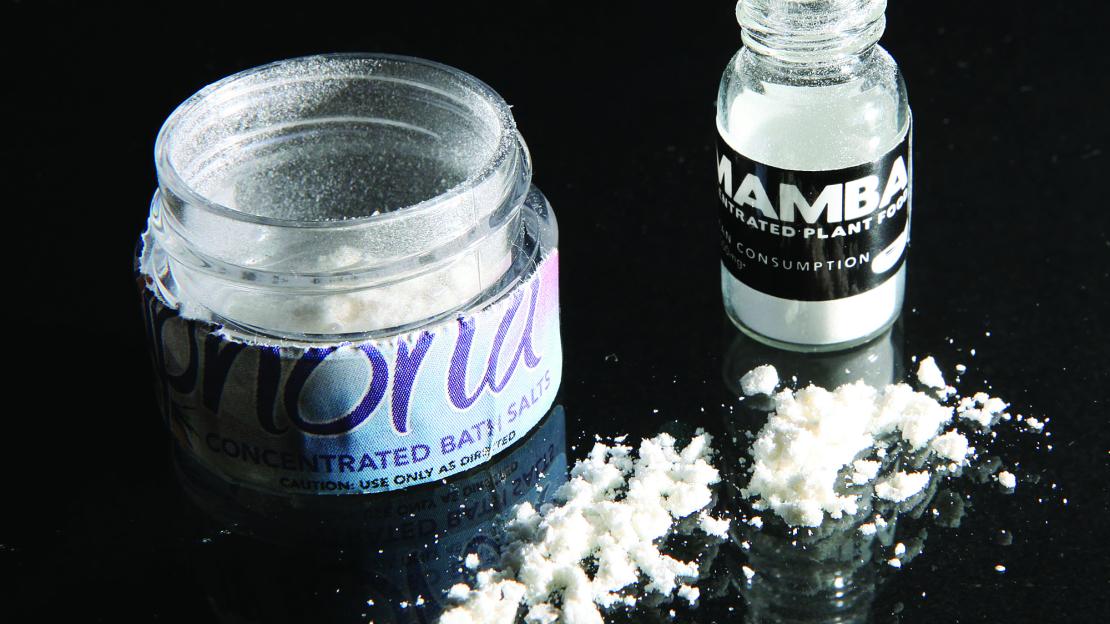In the wake of sensationalized media reports over the past year, the term “bath salts” has taken on a whole new meaning. Originally used to refer to bath-enhancing water-soluble products, the term now applies as well to a category of substances with potent psychogenic and hallucinogenic effects that would characterize them as anything but harmless.
These redefined bath salts belong to a family of designer drugs whose key ingredient is typically one of the synthetic cathinones, most commonly mephedrone, methylone or 3,4-methylenedioxypyrovalerone (MDPV). Cathinone is found naturally in the leaves of the Catha edulis—commonly known as khat—a flowering shrub indigenous to East Africa and the Middle East. Khat’s psychogenic effects, achieved by chewing the plant’s leaves and twigs, are reportedly similar to the effects of exposure to amphetamine or cocaine.
Synthetic cathinones were first produced in the late 1920s, and MDPV was patented by the German pharmaceutical company Boeringer Ingelheim in 1969 but, not surprisingly, never marketed. In fact, MDPV faded into obscurity until the late 1990s, when a recipe for producing it and descriptions of its powerful effects were published on The Hive, a recreational-drug-use website that was later taken down, in 2004.
In the ensuing years, the use of bath salts increased dramatically, but their widespread popularity among club goers in Europe and elsewhere emerged only in the mid-2000s. Today, synthetic cathinones are manufactured primarily in Asia and Europe, and importation laws are skirted because the drugs are marketed as innocuous products and labelled as, well, “bath salts” with names like Vanilla Sky and White Dove, or even packaged as “plant food.”
The main pharmacological effect of synthetic cathinones is an increase in dopamine, serotonin and norepinephrine levels in the brain. The fact that they have such potent effects on the dopamine system is especially concerning, given that this is the brain’s primary reward system and is most directly associated with the addictive potential of drugs.
Bath salts users typically report experiencing intense euphoria, heightened alertness, energy, talkativeness and increased sexual arousal. Other symptoms include hypertension, tachycardia (fast or irregular heart rate), hyperthermia (elevated body temperature) and generalized anxiety and restlessness. Users who snort bath salts have also described much more extreme and bizarre behaviours, such as severe aggression, wild displays of phenomenal physical strength, self-mutilation, suicidal thoughts or attempts, and persistent paranoid psychosis—symptoms that have dominated recent news headlines around the world.
The rise in cathinone usage has pushed law enforcement agencies as well as medical and other regulatory bodies to take action. In 2008 Israel became the first country to ban MDPV and several European nations soon followed suit. In Canada and the U.S., however, although the current legal status of synthetic cathinones varies considerably by substance and jurisdiction, the drugs continue to be available on the Internet and in drug-paraphernalia retail outlets, where they are described as “legal highs.” Legislation is currently being drafted to ban these substances here.
Because of the potentially life-threatening effects of this drug family, there is an urgent need to characterize their pharmacological profile and medical toxicology. Alerts about the potential dangers of bath salts to public health—along with commitments to monitor the extent, pharmacology and consequences of their use—have been issued by several Canadian and U.S. organizations that influence policy on issues related to substance dependence.
As interest in these drugs has been relatively recent, very little is known about their long-term effects, and there has been no focused research effort to study their abuse potential or to characterize a withdrawal syndrome. Nevertheless, there are several early and compelling indicators that justify the need for systematic research in this area. First, like other drugs with high abuse liability, synthetic cathinones activate the dopamine reward pathway in a very potent way; at least one of these substances, mephedrone, has already been found to be readily self-administered by rats (propensity for drug self-administration in rats is highly predictive of a drug’s abuse potential in humans). Users have also described strong cravings to repeat or increase doses of the drug and to prolong its effects over sessions that reportedly last from several hours to several days. This pattern of drug administration is remarkably similar to the binge pattern that characterizes amphetamine and cocaine dependence.
Fortunately, with the increased popularity and media attention surrounding these drugs, basic research has been bolstered, with 80 percent of all existing studies on the major synthetic cathinones found in bath salts published in the last two years. Hopefully this surge in research foreshadows a concentrated effort to systematically study and characterize their abuse potential. Such data will be vital in addressing the current—and future—public health problems posed by this worrisome new wave of drugs.
Suzanne Erb is an associate professor of psychology at UTSC.
